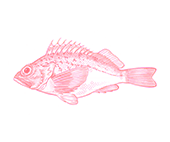




- Eat Less
Wild Caught
Region:
SA
Note: Mulloway that is linecaught from SA has lower bycatch impacts and can be considered a green, “Better Choice”.
- Mulloway are a large predatory fish found around surf beaches, coastal reefs and inlets and estuaries throughout subtropical and southern Australia
- Mulloway are caught by bottom gillnet, haul seine net and line fishing methods in SA.
- the connection between environmental variation (river flow) and the breeding success of mulloway is well recognised and is used as the basis to set catch levels. Populations are considered healthy.
- While line fishing is unlikely to significantly impact marine wildlife, there are concerns over overfished bycatch species caught in gillnet fishing in SA.
- SA Lakes and Coorong Fishery and Marine Scalefish Fishery (92t in 2020/21)
Mulloway is a large predatory fish widely distributed throughout inshore coastal marine and estuarine sandy and reef environments; and is targeted by commercial and recreational fisheries around subtropical and southern Australia. The recreational catch in some states in Australia is a significant portion of the overall catch of mulloway, and can equal or exceed commercial landings.
The distribution of mulloway stocks around SA is uncertain, as while it is assumed there is one stock throughout southern Australian there is evidence of finer scale separation within each State’s waters.
In SA, most mulloway are caught using gillnets in the Lakes and Coorong Fishery, which is highly dependent on the health of the Murray River. A recent welcome move by fishery managers has been to explicitly monitor and build these important environmental factors into managing the mulloway catch.
There have been issues with increasing interactions between newly established long-nosed fur seal populations and Lakes and Coorong net fishers, which is a cause of some concern. While these issues are being addressed by management and it appears that the risk to these protected species has been reduced, it will take some time to be confident that these protective measures are adequate. There is also a potentially significant amount of overfished black bream bycatch associated with gillnet fishing for mulloway.
Independent observer coverage would provide confidence in the records of endangered wildlife interactions. Line fishing for mulloway poses negligible risk to protected species, and represents a more sustainable choice if available.


